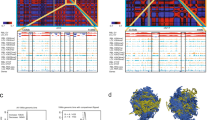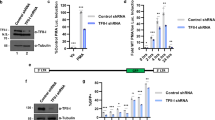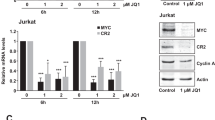Abstract
The cellular transcriptional repressor RBP-Jκ associates with the Epstein–Barr virus nuclear antigens (EBNAs) determined to be essential for transformation of human primary B lymphocytes. It was demonstrated through genetic analysis that interaction between the viral transactivator EBNA2 and RBP-Jκ is essential for EBV immortalization of primary B lymphocytes. We have shown that the association of RBP-Jκ with intracellular NOTCH1 differs significantly in B and T cells. Immunoprecipitation analyses with antibodies to both the intracellular forms of NOTCH1 and to RBP-Jκ demonstrated that little or no RBP-Jκ is associated with NOTCH1 in B cell lines compared to the RBP-Jκ associated with NOTCH1 in T cell lines and was further demonstrated in human primary lymphocytes. Additionally, EBNA2 can compete with intracellular NOTCH1 for binding to GST-RBP-Jκ in vitro. Northern blot for the cellular gene hairy enhancer of split (HES1) demonstrated that HES1 is upregulated in the EBV transformed lymphoblastoid cells expressing high levels of EBNA2 and in a T cell line SupT1 overexpressing intracellular activated NOTCH1. Hence, EBNA2 may be able to compete for the available pool of RBP-Jκ more effectively in human B cells than in T cells and provides a possible explanation for the ability of EBV to potently and efficiently infect and immortalize human B cells.
This is a preview of subscription content, access via your institution
Access options
Subscribe to this journal
Receive 12 print issues and online access
$259.00 per year
only $21.58 per issue
Buy this article
- Purchase on Springer Link
- Instant access to full article PDF
Prices may be subject to local taxes which are calculated during checkout






Similar content being viewed by others
References
Reynolds TC, Smith SD, Sklar J . Analysis of DNA surrounding the breakpoints of chromosomal translocations involving the β T cell receptor gene in human lymphoblastic neoplasms Cell 1987 50: 107–117
Ellisen LW, Bird J, West D, Soreng A, Reynolds T, Smith S, Sklar J . TAN-1, the human homolog of the Drosophila Notch gene, is broken by chromosomal translocations in T lymphoblastic neoplasms Cell 1991 66: 649–661
Weinmaster G, Roberts VJ, Lemke G . A homolog of Drosophila Notch expressed during mammalian development Development 1991 113: 199–205
Aster J, Pear W, Hasserjian R, Erba H, Davi F, Luo B, Scott M, Baltimore D, Sklar J . Functional analysis of the TAN-1 gene, a human homolog of Drosophila notch Cold Spring Harbor Sym Quant Biol 1994 59: 125–136
Aster JC, Robertson E, Hasserjian R, Turner J, Kieff E, Sklar J . Oncogenic forms of NOTCH1 lacking either the primary binding site for RBP-Jkappa or nuclear localization sequences retain the ability to associate with RBP-Jkappa and activate transcription J Biol Chem 1997 272: 11336–11343
Pear WS, Aster J, Scott M, Hasserjian R, Soffer B, Sklar J, Baltimore D . Exclusive development of T cell neoplasms in mice transplanted with bone marrow expressing activated Notch alleles J Exp Med 1996 183: 2283–2291
Rebay I, Fortini ME, Artavanis-Tsakonas S . Analysis of phenotypic abnormalities and cell fate changes caused by dominant activated and dominant negative forms of the Notch receptor in Drosophila development CR Acad Sci III 1993 316: 1097–1123
Fortini ME, Rebay I, Caron L, Artavanis-Tsakonas S . An activated Notch receptor blocks cell-fate commitment in the developing Drosophila eye Nature 1993 365: 555–557
Coffman CR, Skoglund P, Harris W, Kinter C . Expression of an extracellular deletion of Notch diverts cell fates in Xenopus embryos Cell 1993 73: 659–671
Lindsell CE, Boulter J, DiSibio G, Grossler A, Weinmaster G . Expression patterns of Jagged, Delta1, Notch1, Notch2, and Notch3 genes identify ligand-receptor pairs that may function in neural development Mol Cell Neurosci 1996 8: 14–27
Austin CP, Feldman D, Ida J, Cepko C . Vertebrate retinal ganglion cells are selected from competent progenitors by the action of Notch Development 1995 121: 3637–3650
Matsunami N, Hamaguchi Y, Yamamoto Y, Kuze K, Kangawa K, Matsuo H, Kawaichi M, Honjo T . A protein binding to the Jκ recombination sequence of immunoglobulin genes contains a sequence related to the integrase motif Nature (London) 1989 342: 934–937
Dou S, Zeng X, Cortes P, Erdjument-Bromage H, Tempst P, Honjo T, Vales L . The recombination signal sequence-binding protein RBP-2N functions as a transcriptional repressor Mol Cell Biol 1994 14: 3310–3319
Henkel T, Ling P, Hayward S, Peterson M . Mediation of Epstein–Barr virus EBNA2 transactivation by recombination signal-binding protein Jκ Science 1994 265: 92–95
Grossman S, Johannsen E, Tong X, Yalamanchili R, Kieff E . The Epstein–Barr virus nuclear antigen 2 transactivator is directed to response elements by the J kappa recombination signal binding protein Proc Natl Acad Sci USA 1994 91: 7568–7572
Yochem J, Greenwald I . glp-1 and lin-12, genes implicated in distinct cell–cell interactions in C. elegans, encode similar transmembrane proteins Cell 1989 58: 553–563
Fortini ME, Artavanis-Tsakonas S . The suppressor of hairless protein participates in notch receptor signaling Cell 1994 79: 273–282
Bailey AM, Posakony JW . Suppressor of hairless directly activates transcription of enhancer of split complex genes in response to Notch receptor activity Genes Dev 1995 9: 2609–2622
Lecourtois M, Schweisguth F . The neurogenic suppressor of hairless DNA-binding protein mediates the transcriptional activation of the enhancer of split complex genes triggered by Notch signaling Genes Dev 1995 9: 2598–2608
Lambie EJ, Kimble J . Two homologous regulatory genes, lin-12 and glp-1, have overlapping functions Development 1991 112: 231–240
Christensen S, Kodoyianni V, Bosenberg M, Friedman L, Kimble J . lag-1, a gene required for lin-12 and glp-1 signaling in Caenorhabditis elegans, is homologous to human CBF1 and Drosophila Su(H) Development 1996 122: 1373–1383
Ling PD, Rawlins DR, Hayward SD . The Epstein–Barr viral immortalizing protein EBNA-2 is targeted to DNA by a cellular enhancer-binding protein Proc Natl Acad Sci USA 1993 90: 9237–9241
Hsieh JJ, Henkel T, Salmon P, Robey E, Peterson M, Hayward S . Truncated mammalian Notch1 activates CBF1/RBPJκ-repressed genes by a mechanism resembling that of Epstein–Barr virus EBNA2 Mol Cell Biol 1996 16: 952–959
Zimber-Strobl U, Strobl L, Meitinger C, Heinrichs R, Sakai T, Furukawa T, Honjo T, Bornkamm G . Epstein–Barr virus nuclear antigen 2 exerts its transactivating function through interaction with recombination signal binding protein RBP-J kappa, the homologue of Drosophila suppressor of hairless EMBO J 1994 13: 4973–4982
Sakai T, Taniguchi Y, Tamura K, Minoguchi S, Fukura T, Strobl L, Zimber-Strobl U, Bornkamm G, Honjo T . Functional replacement of the intracellular region of the Notch1 receptor by Epstein–Barr virus nuclear antigen 2 J Virol 1998 72: 6034–6039
Tamura K, Taniguchi Y, Minoguchi S, Sakai T, Tun T, Furukawa T, Honjo T . Physical interaction between a novel domain of the receptor Notch and the transcription factor RBP-J kappa/Su(H) Curr Biol 1995 5: 1416–1423
Yalamanchili R, Tong X, Grossman S, Johannsen E, Mosialos G, Kieff E . Genetic and biochemical evidence that EBNA 2 interaction with a 63-kDa cellular GTG-binding protein is essential for B lymphocyte growth transformation by EBV Virology 1994 204: 634–641
Johannsen E, Koh E, Mosialos G, Tong X, Kieff E, Grossman S . Epstein–Barr virus nuclear protein 2 transactivation of the latent membrane protein 1 promoter is mediated by Jκ and PU.1 J Virol 1995 69: 253–262
Hasserjian RH, Aster J, Davi F, Weinberg D, Sklar J . Modulated expression of NOTCH1 during thymic development Blood 1996 88: 970–976
Robertson ES, Grossman S, Johannsen E, Miller C, Lin J, Tomkinson B, Kieff E . Epstein–Barr virus nuclear protein 3C modulates transcription through interaction with the sequence-specific DNA-binding protein J kappa J Virol 1995 69: 3108–3116
Smith SD, McFall P, Morgan R, Link M, Hecht F, Clearly M, Sklar J . Long-term growth of malignant thymocytes in vitro Blood 1989 73: 2182–2187
Robertson ES, Lin J, Kieff E . The amino terminal domains of Epstein–Barr nuclear proteins 3A, 3B, and 3C interact with RBPJκ J Virol 1996 70: 3068–3074
Jarriault S, Brou C, Logeat F, Schroeter E, Kopan R, Israel A . Signaling downstream of activated mNotch Nature 1995 377: 355–358
Artavanis-Tsakonas S, Matsuno K, Fortini ME . Notch signaling Science 1995 268: 225–232
Wang F, Kikutani H, Tsang S, Kishimoto T, Kieff E . Epstein–Barr virus nuclear protein 2 transactivates a cis-acting CD23 DNA element J Virol 1991 65: 4101–4106
Cohen JI, Wang F, Mannick J, Kieff E . Epstein–Barr virus nuclear protein 2 is a key determinant of lymphocyte transformation Proc Natl Acad Sci USA 1989 86: 9558–9562
Waltzer L, Logeat F, Brou C, Israel A, Sergeant A, Manet E . The human Jκ recombination signal sequence binding protein (RBP-Jκ) targets the Epstein–Barr virus EBNA2 protein to its DNA responsive elements EMBO J 1994 13: 5633–5638
Hsieh JJ, Hayward SD . Masking of the CBF1/RBPJ kappa transcriptional repression domain by the Epstein–Barr virus EBNA2 Science 1995 268: 560–563
Ling PD, Hayward SD . Contribution of conserved amino acids in mediating the interaction between EBNA2 and CBF1/RBPJκ J Virol 1995 69: 1944–1950
Marshall D, Sample C . Epstein–Barr virus nuclear antigen 3C is a transcriptional regulator J Virol 1995 69: 3624–3630
Zhao B, Marshall DR, Sample CE . A conserved domain of the Epstein–Barr virus nuclear antigens 3A and 3C binds to a discrete domain of Jkappa J Virol 1996 70: 4228–4236
Busseau I, Diederich R, Xu T, Artavanis-Tsakonas S . A member of the Notch group of interacting loci, deltex encodes a cytoplasmic basic protein Genetics 1994 136: 585–596
Diederich RJ, Matsuno K, Hing H, Artavanis-Tsakonas S . Cytosolic interaction between deltex and Notch ankyrin repeats implicates deltex in the Notch signaling pathway Development 1994 120: 473–481
Matsuno K, Eastman D, Mitsiades T, Quinn A, Carcanciu M, Ordentlich P, Kadesh T, Artavanis-Tsakonas S . Human deltex is a conserved regulator of Notch signaling Nat Genet 1998 19: 74–78
Johannsen E, Miller C, Grossman S, Kieff E . EBNA-2 and EBNA-3C extensively and mutually exclusively associate with RBPJκ in Epstein–Barr virus-transformed B lymphocytes J Virol 1996 70: 4179–4183
Acknowledgements
ESR is a Scholar of the Leukemia Society of America. This work was supported by grants from the Leukemia Society of America, the American Heart Association (to ESR) and National Cancer Institute Grants CA66849 (to JCA), CA47006 (to EDK), CA62450 (to JS) and CA072150 (to ESR).
Author information
Authors and Affiliations
Rights and permissions
About this article
Cite this article
Callahan, J., Aster, J., Sklar, J. et al. Intracellular forms of human NOTCH1 interact at distinctly different levels with RBP-Jkappa in human B and T cells. Leukemia 14, 84–92 (2000). https://doi.org/10.1038/sj.leu.2401630
Received:
Accepted:
Published:
Issue Date:
DOI: https://doi.org/10.1038/sj.leu.2401630
Keywords
This article is cited by
-
Therapeutic modulation of Notch signalling — are we there yet?
Nature Reviews Drug Discovery (2014)
-
Notch-1 and Notch-2 exhibit unique patterns of expression in human B-lineage cells
Leukemia (2000)



